
Are Apples Good For You? Here Are 8 (Surprising) Reasons Why!
There is a reason why people say ‘an apple a day keeps the doctor away’.
The intake of fruits and vegetables has been shown time and again to help lower the risk of developing heart attacks and strokes. For example, in one study that looked at 84000 women and 42000 men followed up for 14 years and 8 years respectively, those that consumed the highest amount of fruits and vegetables had a 20% lower risk of developing heart attacks.
In particular, apples contain flavonoids, and studies have found that regular flavonoid intake lowers your mortality rate from chronic diseases.
Apples are the second most consumed fruit in the world, with bananas at the top of the list. It’s not just the variety, crunch and the taste of apples that make it a world-wide favorite; it has a number of health benefits too.
If you have been wondering if apples are good for your health, I have today 8 reasons why you should munch on these beauties when you get a chance.
Nutritional Value Of Apples
Your average Joe apple contains fructose as the main sugar, and is low in fat. It is also rich in vitamin C and E, potassium, magnesium and fiber (both soluble and insoluble), along with polyphenols.
Most apples contain around 2 – 3% fiber in them. Pectin is the main soluble fiber that has many health benefits. The insoluble fiber includes cellulose and hemicellulose.
The pectin escapes digestion in the stomach, and heads over to the intestine, where it forms a gel that coats the inner aspect of the bowel. Here, it is fermented with the micro-organisms in the gut, leading to the formation of short chain fatty acids (SCFAs). These SCFAs have multiple positive health effects.
The apple peel forms about 6 – 8% of the fruit, but has the highest concentration of phenolics. The phenolics are powerful antioxidants. Make sure you do not peel your apple before eating it. Juicing can remove the healthy polyphenols. Cloudy juice may be better than clear juice.
Are Apples Good For You?
I would love to stand on a rooftop and shout ‘YES!’. Apples are an amazing fruit to eat every day.
The benefits of eating apples stems from the presence of compounds called phenolics. These have numerous antioxidant and anticancer properties. Apples are particularly high in ‘free phenolics’, meaning these compounds are available in greater proportions compared to other fruits.
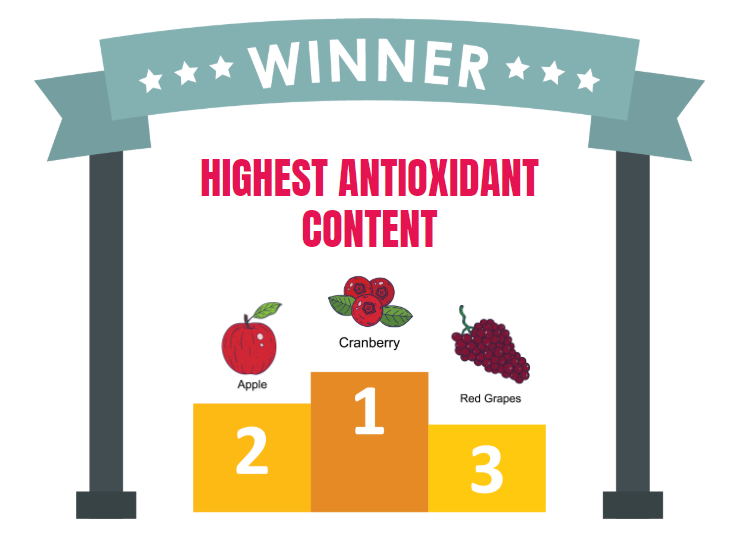
If you look at antioxidant activity alone, apples rank second, coming close to cranberries that rank first. This is primarily due to the high concentration of vitamin C that is available in this fruit.
Apples Lower Your Risk Of Cancer
Apple intake can lower your chances of developing cancer, research has shown.

In a study that looked at 77000 women and 47000 men, fruit and vegetable intake on a regular basis lowered the risk of lung cancer by 21% in women, but not in men (!!). Apples seem to have a great benefit particularly. Just one serving a day (1 apple) appeared to do the job.
However, another study found that consumption of apples and onions lowered lung cancer risk in both men and women (phew!).
Similarly, researchers have found regular consumption of at least one apple a day lowered the risk of cancer of the bowel (colorectal cancer).
Besides this, there are research groups that have found that apple intake (one or more) everyday lowered the risk of cancer of the oral cavity, esophagus (food pipe), breast, ovary and prostate.
Some of this has been demonstrated well in lab based studies, where it was found that extracts from the peel of an apple (they used Gala apples) reduced the growth rate of cancer cells in prostate and breast cancer tissues. This is because the extract increased the level of a protein called maspin, which slowed down the cancer cell growth.
Pectin, another component found in apples, is a soluble fiber that can lower the spread of cancer, as demonstrated in animal studies. It does so by inducing a phenomenon called apoptosis, which is the medical term for programmed cell death.
The research on whether apples can lower your risk of cancer is solid. It appears an apple a day (around 166 gm) is sufficient enough.
They Can Protect Your Heart
As I have mentioned earlier, apples are rich in compounds called flavonoids. In the Women’s Health Study, a trial that followed up 40000 women over a period of almost 7 years, ingestion of a high quantity of flavonoids lowered the risk of heart disease by 35%.

A similar study looking at apple and wine intake found a lower death rate in women from coronary disease. This was due to compounds called catechins and epicatechins.
High cholesterol is a risk factor in the development of heart disease and stroke. The high polyphenol and fiber content of apples has been shown in studies to lower levels of LDL i.e. bad cholesterol.
Apples have a better cholesterol lowering effect compared to pears and peaches. It appears apples prevent excess cholesterol from being absorbed in the intestine, as evidenced by a higher fat content in the stools.
This would lower your risk of heart attacks.
There are studies looking at apple intake and risk of stroke, and a similar association has been seen. If you eat an apple a day, you could lower your risk of stroke.
Apples Are Great In Diabetes
Are apples safe in diabetics?
If you suffer from diabetes, then apples are a great fruit to eat. Apples have a low glycemic index, which means they do not increase your blood sugar much if you eat them.
Quercetin, a powerful antioxidant in apple peel, has been shown to lower the chance of developing type 2 diabetes by slowing down how fast the body breaks down the food you eat. It also protects the heart and prevents cancer at the same time.
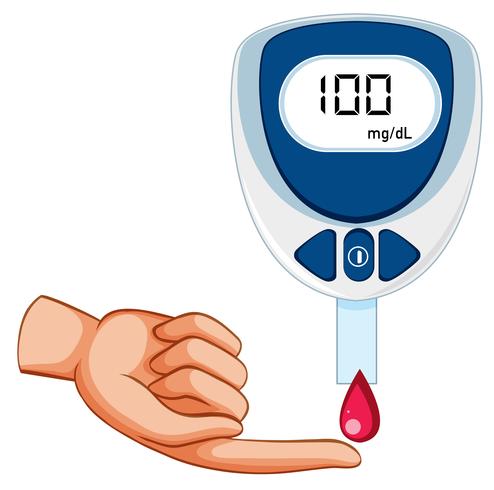
Similarly, chlorogenic acid and phlorizin, also antioxidants, can help your body utilize the sugar in your foods more efficiently. They also help lower blood sugar at the same time.
At the core of diabetes is a phenomenon called insulin resistance. Here, your body does not respond to the natural insulin being secreted by the pancreas. In other words, the insulin does not work, and hence the glucose levels increase.
Mouse studies have found apple polyphenol extracts to improve sensitivity to insulin (in other words, it lowers insulin resistance). This in turns would improve blood sugar levels as well.
These polyphenols have also been shown to lower postprandial glucose spikes, making it a great snack if you wish to fill up your stomach without worrying about your blood sugar rising.
When it comes to preventing diabetes, apples take the cake. Regular intake of one apple everyday of the week can lower your risk of developing type 2 diabetes by 28%, research has found.
If you like fruit juice, then choosing a 100% juice option is better. Don’t purchase ones with added sugar. It appears that consuming 100% fruit juice may not have too much of an impact on your blood sugar control.
Improves Asthma And Lung Health
I must admit – this was an eye-opener for me. I had no idea that apples could help people with asthma and lung problems.

Lung problems are common in India. The pollution levels are sky-high, and exposure to cancer-forming particles is increasing the incidence of asthma and chronic lung disease (wheezing).
But there is great news. If you eat an apple a day, you can power up your lung health.
In fact, evidence suggests that regular apple consumption could improve the function of your lungs, and build local immunity. There appears to be greater benefit in those who consume 5 or more apples a week. Even consuming just 15% or more of a large apple can lower the incidence of asthma by 10%!
The benefit of apples for lung health is due to the flavonoids (quercetin, hesperetin and naringenin).
Boosts Your Memory
As we get older, memory loss is to be expected. But some encounter it at a younger age, and it can be quite frustrating.
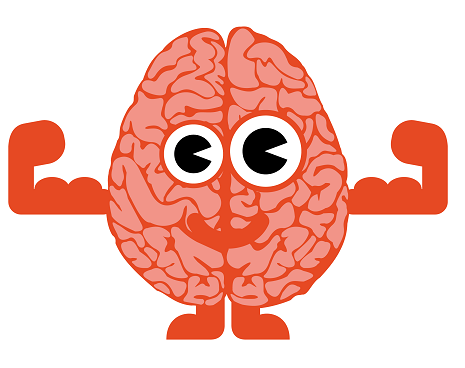
In a mouse model of an Alzheimer’s disease study, it was found that mice that were fed apple juice regularly demonstrated an improvement in cognitive function and memory.
In humans, it is believed that apples may lower the rate of decline of a chemical in the brain called acetylcholine. It also suppresses the expression of a protein called presenilin-1, which is closely linked to Alzhiemer’s disease.
By doing so, it improves memory and lowers the chance of developing Alzheimer’s disease.
Apples May Help You Lose Weight
If you are looking to lose weight with a health diet, then make sure you include apples in it.

The high fiber content in apples makes it a great snack. It’s not just packed with nutrition, but the fiber in it can keep your stomach full for longer. This will prevent you from snacking on junk food.
The weight loss you experience with apple intake is probably just modest.
In one study that compared women who consumed 3 apples, 3 pears and oat cookies everyday, the weight loss was seen most in those who consumed apples.
May Strengthen Your Bones
Osteoporosis, or brittle bone syndrome, is a common problem seen as we get older. It is particularly common in post-menopausal women.
Apple intake on a daily basis may help enhance bone density by lowering the loss of calcium from the body and improving its uptake to form new bone.
However, when compared head to head to dried prunes, dried apples did not have much benefit in protecting the bones.
Among all the fruits, it appears prunes have the best bone protective effect. I will be talking about this in another post.
Apples May Protect Your Stomach Lining
Painkillers are notorious at causing acidity related symptoms. It appears that apples can protect the lining of the stomach, which in turn can reduce your chance of developing ulcers in the stomach.
Acidity in the stomach is sometimes linked to a bacteria called Helicobacter pylori. This bacteria, if left untreated, can lead to bad gastritis and even stomach cancer. The polyphenols in apple peel can help fight this bacteria.
Some Trivia For You
The aphorism ‘an apple a day keeps the doctor away’ originates from Wales.
A slightly different format of this aphorism was published in 1866 as a form of a rhyme ‘eat an apple on going to bed and you’ll keep the doctor from earning his bread’. It was rephrased in 1913.
By the way, there has been a study looking at whether eating an apple everyday lessens your chance of visiting the doctor.
Well, it does not.
However, those who do eat it everyday are less likely to have more medicines prescribed over their lifetime.
Storing Your Apples
The best way to store your apples is to refrigerate them. They can last for 1 to 2 months this way, and remain crisp. Make sure you keep them away from other fruits that might require ripening. This is because an apple that is ripening emits ethylene, which can ripen nearby produce.
Kept at room temperature, apples will likely over-ripen within 2 weeks.
Closing Remarks
I hope this answers your question – ‘are apples good for you?’. There are so many health benefits, it would be a shame if you did not munch on one everyday.
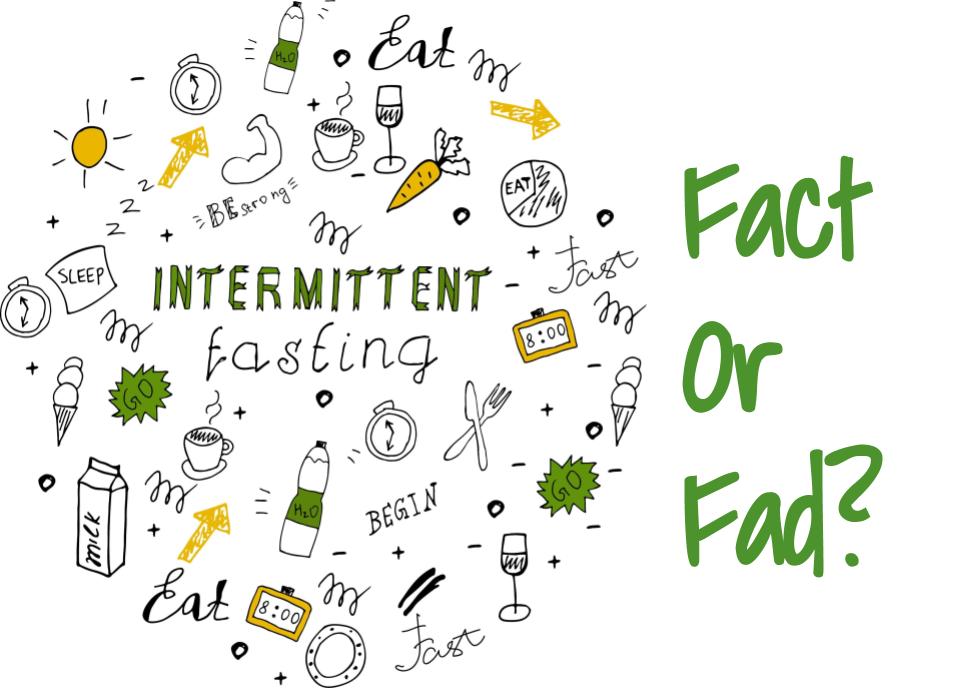
Intermittent Fasting For Weight Loss – Fact Or Fad?
Obesity is gripping the world. People are moving from one diet to another with desperate hope that one of them will work.
Enter intermittent fasting.
Yet another way to lose weight. Some have knocked it before they tried it; some have given it a half-hearted go.
But many have found trying intermittent fasting for weight loss to be a success.
So I thought I would give you a brief overview of this type of diet, and hopefully clarify your doubts on how it should be done and what to expect.
But first….
Terms To Know
Here are some terms I will be using in this article. Feel free to refer back to them as and when you read the article.
Intermittent Fasting (IMF)
What is intermittent fasting?
It is a form of intermittent energy restriction. It includes a >60% restriction in total energy consumed on 2 to 3 days a week.
An example is having a normal diet 4 days a week, and restricting the quantity of food and total calorie intake the remaining 3 days of the week.
Time-Restricted Feeding (TRF)
This is a variant of intermittent fasting. The period of food intake is limited to 8 hours a day, following which the calories are restricted.
An example is eating breakfast at 7 am and lunch at 3 pm, and nothing after that till the day after.
There are 3 patterns that people follow – 16/8, 18/6 and 20/4. 20/4 indicates a 20 hour fast along with 4 hours when food is consumed.
Some consider intermittent fasting and time restricted feeding to be the same thing. For the purposes of this article, we shall do so too.
Continuous Energy Restriction (CER)
This is where the total calories consumed are reduced by 500 to 750 kcal per day or a 30% reduction of what the individual needs at the baseline.
It is a hard diet to adhere to, and many falter and give up within 4 months of starting CER, making them gain back all the weight they lost!
Alternate Day Fasting (ADF)
In this variant, the person eats 75% of their normal intake on one day, and to their heart’s content on the next day, thus alternating between the two.
Does Intermittent Fasting Work As A Diet?
Given how people have been trying continuous energy restriction for years on end, it is natural that most clinical studies would look at whether intermittent fasting is better or comparable to this.
Human studies are hard to conduct as people tend to give up during the study period. On an average, burn out ranges between 0 to 60%. Hence, most of the information comes from animal studies and a few human trials.
Intermittent Fasting For Weight Loss
I start with this subsection, as most people who take up fasting of any sorts are doing it for one reason – to lose body weight.
When I talk about body weight, what I am primarily referring to in this article is body fat content. It is the excessive body fat that is responsible for heart disease and diabetes, so reducing that becomes of prime importance.

Generally, when you lose body fat, you lose body weight as well.
When we eat our food, it is broken down by digestive enzymes into glucose and other components that are needed for normal cells and vital organ functioning.
Glucose is absorbed into the bloodstream and thereon goes to provide energy to all vital structures of the body. The excess glucose generated is stored in the liver in the form of glycogen.
Anything over and above what the body needs is stored as body fat.
In other words, if you eat too much, a large part of what you eat will get converted to body fat, thus raising your body weight.
When you perform intermittent fasting, you make drastic changes to your body’s metabolism.
Let us take an example where you might be following the 8/16 protocol. When you consume food during the 8 hour period, your body glucose level remains high during that time and for a few hours after that. For about 16 hours or so after, during the fasting period, the glucose levels begin to drop.

Adaptive mechanisms kick in to keep the vital organs going, and glycogen from the liver begins to get utilised. Once this is emptied out, the body begins a process called gluconeogenesis, or ‘new glucose’ release. This is generated from the breakdown of fat cells.
As more and more of these fat cells breakdown to provide energy, the total body fat content begins to reduce. This leads to weight loss due to body fat loss.
Mouse studies have shown that the weight loss experienced could range between 13 to 18% on an alternate day fasting regime.
Human studies are limited, and while they too have shown modest weight loss in subjects performing time restricted feeding, there does not seem to be much difference to continuous energy restriction. However, the time restricted feeding group had more overall body fat loss.
In other words, available studies state there is no difference between the weight loss you would experience by performing intermittent fasting compared to just reducing the calories you consume every day.
But if you were never dieting and have now taken up intermittent fasting, then you would expect to lose around 6.5 – 7% of your body weight over an 8 to 12 week period, according to some studies.
This is actually pretty good!
So, if you are planning to take up intermittent fasting for weight loss, then you can be assured to lower your body fat, provided you stick with the regime for a few months at least.
I thought I would touch upon some other important aspects of intermittent fasting as well here.
Intermittent Fasting And Blood Pressure
Intermittent fasting has a positive effect on blood pressure control, and this too has been proven in clinical and animal studies.

A study conducted at the Buchinger Wilhelmi clinic in Germany looked at 1422 individuals subjected to fasting periods over 4 to 21 days. They were restricted to 250 calories per meal as well.
Over a period of one year, these individuals had a lower systolic and diastolic blood pressure control. The lowering of blood pressure is understood to be due to hormonal changes and neurological control mechanism alterations that are brought about by fasting.
However, once the fasting was stopped, the blood pressure returned to normal. This makes it important, once again, to stick to the diet.
Multiple human studies have also confirmed the same.
Interestingly, the heart rate of patients included in the study also reduced. This is beneficial as high resting heart rates have a detrimental effect on heart health.
In short, intermittent fasting has long term benefits on lowering blood pressure and heart rate, provided it is observed for a prolonged period of time.
Intermittent Fasting And Cholesterol
I mentioned earlier about how intermittent fasting can alter the way glucose is handled by the body.
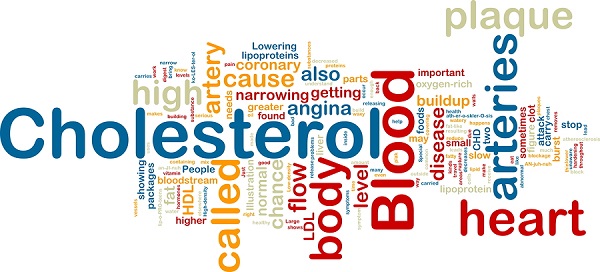
During the fasting phase, all the glucose in the body is exhausted to provide the vital organs with energy. In the process of doing so, new energy has to be generated.
A process called ‘lipolysis’, or fat breakdown begins. The fat cells begin to release fatty acids, which are then transported to the liver. In the liver, these fatty acids undergo a process of oxidation, making them ‘energy-giving’ compounds.
In some time, this leads to changes in the levels of lipids in the body. Blood cholesterol levels are reduced, and animal models have found that the levels of ‘bad’ cholesterol, or LDL, reduce.
Multiple human studies conducted since have shown the same thing, with some even showing elevated levels of good (HDL) cholesterol.
Intermittent Fasting And Diabetes
This is an important one to note, as we currently have nearly 100 million people in our country with diabetes.
 Obesity and leading a sedentary lifestyle are closely related to the development of diabetes. So it stands to reason that lowering body weight, along with regular exercise would prevent diabetes.
Obesity and leading a sedentary lifestyle are closely related to the development of diabetes. So it stands to reason that lowering body weight, along with regular exercise would prevent diabetes.
In patients with type 2 diabetes, intermittent fasting has been found to have numerous benefits, as per a clinical study called the DiRECT trial. In this clinical trial, individuals with type 2 diabetes were given an 850 kcal diet to eat every day for 12 weeks. Each participant lost a significant amount of weight, and this was accompanied with lower fasting blood sugars, lower HbA1c values and improved sensitivity to insulin.
Basically, intermittent fasting makes all the cells of the body respond better to insulin naturally secreted by the pancreas. This means the glucose generated from digestion of food is taken up more effectively by all cells and vital organs.
Intermittent Fasting And Inflammation
I thought I would make a brief mention on the role of intermittent fasting on inflammation.
The reason I wish to is because inflammation is the root cause for heart attacks and strokes. It is the reason fat deposits in the arteries of the heart, leading to atherosclerosis and subsequent heart attacks.
Intermittent fasting has been found to increase the levels of a protein called adiponectin. High levels of adiponectin have a protective effect against the development of heart disease.
In people who are obese, those with diabetes and cardiac disease, the levels of adiponectin are significantly lowered, which increases the risk of atherosclerosis and heart artery ‘blockages’.
Similarly, intermittent fasting lowers the levels of leptin, resistin and similar compounds, all of which are pro-inflammatory and promote atherosclerosis.
In essence, intermittent fasting can lower your risk of heart disease by lowering inflammation within the body.
In A Nutshell
So it is clear that intermittent fasting has many advantages. It can lower weight, lower LDL cholesterol, lower blood pressure and lower the risk of heart attacks and strokes.
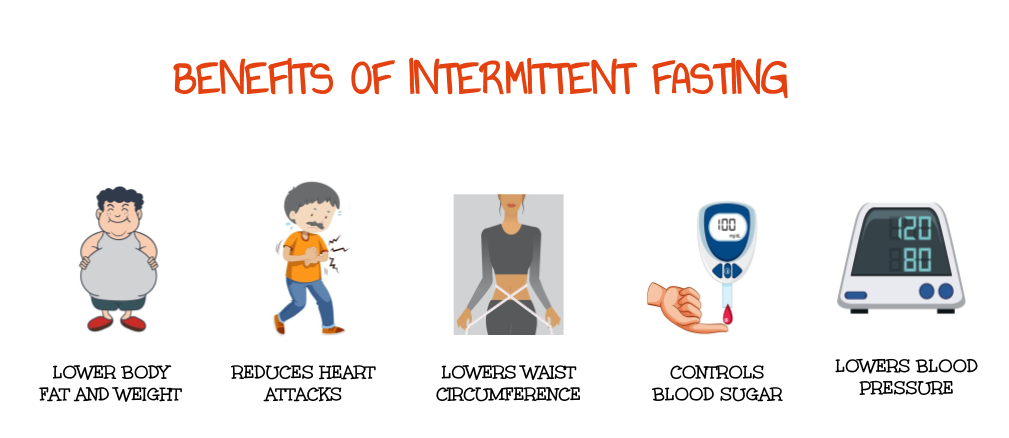
Are There Any Disadvantages of Intermittent Fasting?
Well, with everything good, there is always a little bad.
Firstly, intermittent fasting may not be for everyone. Those with diabetes who attempt this must do it under the supervision of a doctor, as medications normally taken can precipitate low blood sugars.
Some studies have reported mood changes, anger, frustration and argumentative behaviors in those who are starting out.
The results for intermittent fasting that have been published with respect to weight loss are all short term studies. There are no long term studies that have evaluated how effective it is over years. While we know there are multiple advantages, we are still limited in our understanding of how it can help lower health problems over years.
Women who undertake intermittent fasting may find that their monthly menstrual cycles become irregular.
Pregnant women must avoid intermittent fasting as it could affect the health of the growing fetus. The same holds for athletes as it could negatively affect their performance.
On a lighter note, eating out in the evening with friends and family comes down, sadly. But your bank balance may improve over time!!!
Conclusion
Intermittent fasting is an effective way to lose weight and stay healthy. However, it may not be better than just reducing your overall calorie intake everyday.
Unfortunately, long term data regarding its true efficacy is limited, but that should not stop you from taking it up. Do remember that for the most effective weight loss, combine your diet with exercise.
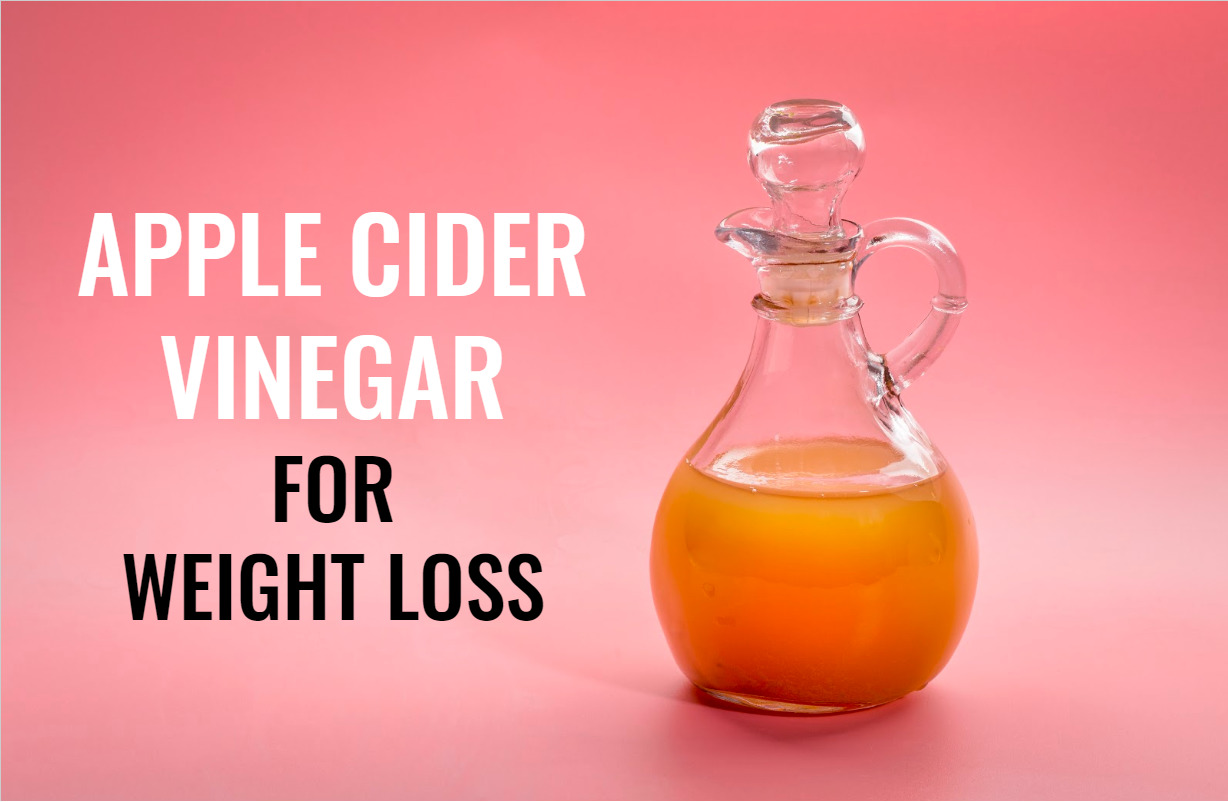
Is Apple Cider Vinegar For Weight Loss The Right Choice?
Over the years, I have heard many of my patients and friends rave on about using apple cider vinegar (ACV) for weight loss. Some even use it for stomach problems.
But does it really work? Is apple cider vinegar really the ‘bees knees’?
I thought I would look at apple cider vinegar’s effects in lowering body weight.
But first, let’s take a look at what apple cider vinegar is.
What Is Apple Cider Vinegar?
The word ‘vinegar’ is derived from the French phrase ‘vin aigre’, which translates to ‘sour wine’.
Basically, apple cider vinegar is the fermented juice of apples that have been crushed. It mostly contains acetic acid, along with other vitamins and minerals.
The basic components that make apple cider vinegar are apples, sugar, and yeast.
When apples are crushed, the juice that is obtained is mixed with yeast, allowing it to undergo ‘alcohol fermentation’. The sugars in the apple juice are converted into alcohol.
A second fermentation process is then conducted using a bacteria called Acetobacter. This generates acetic acid, which forms most of apple cider vinegar.
Apple cider vinegar contains acetic acid along with minerals such as phosphorus, magnesium, potassium, and calcium in it.
During the manufacturing process, a layer called ‘mother of vinegar’ is produced as a part of the fermentation process. This is rich in good bacteria and enzymes. Unfortunately, many companies that make ACV take off this later as it makes the end-product look murky and unpleasant.
If you are looking to buy ACV, then choose the ‘mother of vinegar’ variant to reap more benefits of apple cider vinegar. This is a more natural choice.
Benefits Of Apple Cider Vinegar
There are a plethora of possible health benefits of consuming apple cider vinegar every day. I have listed them in the table below.

Apple Cider Vinegar For Weight Loss
This article mainly explores whether consuming apple cider vinegar can help you lose weight.
While there are articles that have looked at this aspect of its health benefits, in particular, they are mostly animal studies, with limited human trials.
Here is what I found.
Acetic Acid Is A Short-Chain Fatty Acid
I have previously made mention of short-chain fatty acids (SCFAs) in my article about the health benefits of oats.
SCFAs are of prime importance in keeping your gut healthy. They also help you boost your immunity. Within our body, SCFAs are produced when the non-digestible carbohydrates we consume are fermented within the gut.
ACV contains acetic acid as its main component. Research shows that SCFAs can improve satiety, reducing your hunger, and binge eating.
This would suggest that over time, there could be a degree of weight loss observed.
Apple Cider Vinegar As A Weight Loss Supplement
If you search on the internet, you will find thousands of articles that claim ACV intake can lower your body weight. This has made apple cider vinegar a popular weight loss supplement.
Well, that is true to an extent, but the reduction may not be that significant.
Most of the studies that have looked at the loss of fat and body weight are conducted in animals. Human studies are only a few.
If you combine ACV intake with a good diet and exercise regime, you may see some additional benefits. Apple cider vinegar only contains 3 calories per tablespoon.
So don’t fire your gym trainer yet, because by itself it is unlikely to make that much of a difference.
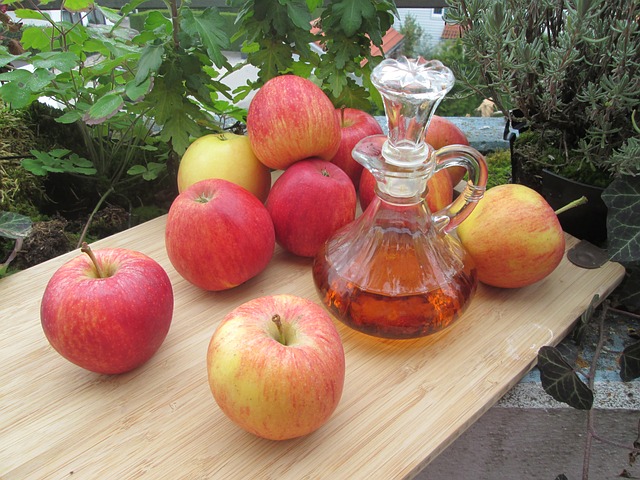
In one study that looked at 39 subjects who were given apple cider vinegar along with a calorie-restricted diet for a period of 12 weeks, there was a significant reduction in body mass index, hip circumference, and appetite, compared to those just on the diet.
In addition to this, there was also a reduction in cholesterol levels and triglyceride values as well. Good cholesterol i.e. HDL values also increased.
As you can see, there is certainly a benefit, but the study size was only just 39 people, which is really too small a size.
A similar study conducted in Japanese subjects looked at 12 weeks of 500 ml of a beverage along with either 0 ml, 15 ml, and 30 ml of acetic acid. Weight loss, reduction in body mass index, and cholesterol values were seen in both vinegar groups compared to the one where no vinegar was administered.
The overall reduction was greater in those consuming 30 ml compared to the other groups.
A small study looking at 10 obese subjects consuming 20 ml of apple cider vinegar at bed-time, there was a lowering of their body mass index seen over a 30 day period.
In a study that looked at obese, high fat diet-fed mice, regular administration of apple cider vinegar lowered their overall fat content in them.
As you can see, there is a mix of studies available. However, it took me forever to find these. There is not much in terms of human studies that stand out robustly declaring apple cider vinegar as an effective weight loss strategy.
Are There Any Side Effects Of Apple Cider Vinegar?
In one case report that looked at a 15-year-old Moroccan girl, tooth enamel erosion, which was inexplicable at first, was found to be due to regular consumption of apple cider vinegar.
Bear in mind that you are consuming vinegar – a mild acid. If you have an undiluted drink of ACV, damage to your tooth enamel should not surprise you.
Individuals taking medication to get rid of extra fluid from their body (diuretics) are at risk of lowering their potassium levels. Low potassium in the blood can affect cardiac function.
As ACV has glucose-lowering properties, bear this in mind if you have diabetes and are taking medication. You may want to consult with your doctor about that, as drug dosages may need to be altered.
My Personal Opinion
If you are looking for a natural weight loss supplement, I am afraid apple cider vinegar is not one of them.
Even if you used it regularly, you might reap some of the benefits that I have listed in the table earlier, but the weight loss you experience will be insignificant.
Try a more proven approach – intermittent fasting, regular moderate-intensity cardio, and yoga instead.
Closing Remarks
Apple Cider Vinegar has some health benefits, but it appears to be a little hyped up when it comes to weight loss. You may want to steer clear if you are using it for that purpose.
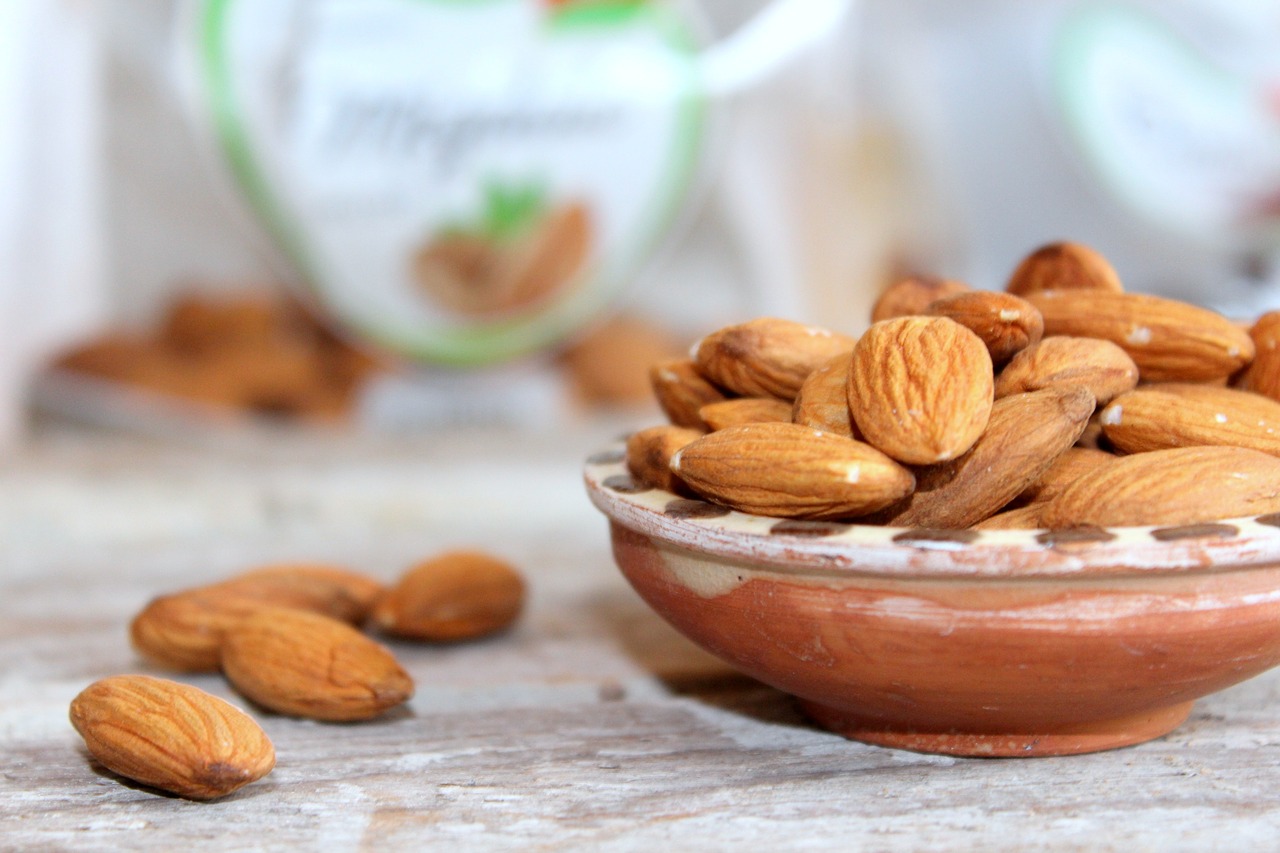
Health Benefits Of Almonds – Why You Should Eat Them Every Day
Almonds are one of my favorite foods to snack on. Their crunch, taste and texture is something I enjoy tremendously.
Time and again, patients ask me whether a handful of almonds are good for health. Some prefer to have a mix of dry fruits, but I often ask them to shift over to almonds.
Today, I will talk about some amazing health benefits of almonds. As always, I keep my word on presenting any benefits listed here with the backing of clinical studies.
What Are Almonds?
The almond is the edible nut of the almond trees, also called Prunus dulcis in the world of biology. Around 80% of the world’s supply of almonds hails from California.
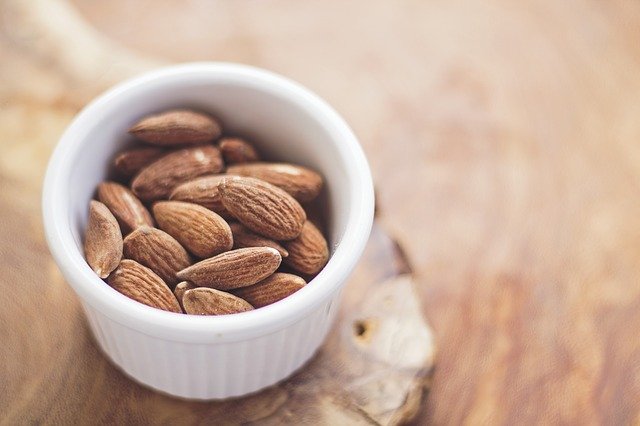
There are two types of almonds – sweet (Prunus dulcis variety dulcis) and bitter (Prunus dulcis variety amara). Sweet almonds are the ones we consume and are used to make almond oil, while bitter almonds are used to make flavoring agents.
Almonds can be consumed either roasted, raw, soaked overnight, and blanched. Almond paste and powder are used commonly in desserts.
Almonds are a nutrient-dense food. I personally believe that a handful of almonds can keep you healthy and your immunity in top shape.
Let’s take a look at why almonds are great for your health.
Nutritional Content Of Almonds
It is hard to imagine that something so small as an almond can be packed with so much power and nourishment.
If you are feeling low in energy, try munching on almonds every day. A 30 gram serving of almonds gives you around 172 kilocalories. This can give you an energy boost when you need it.
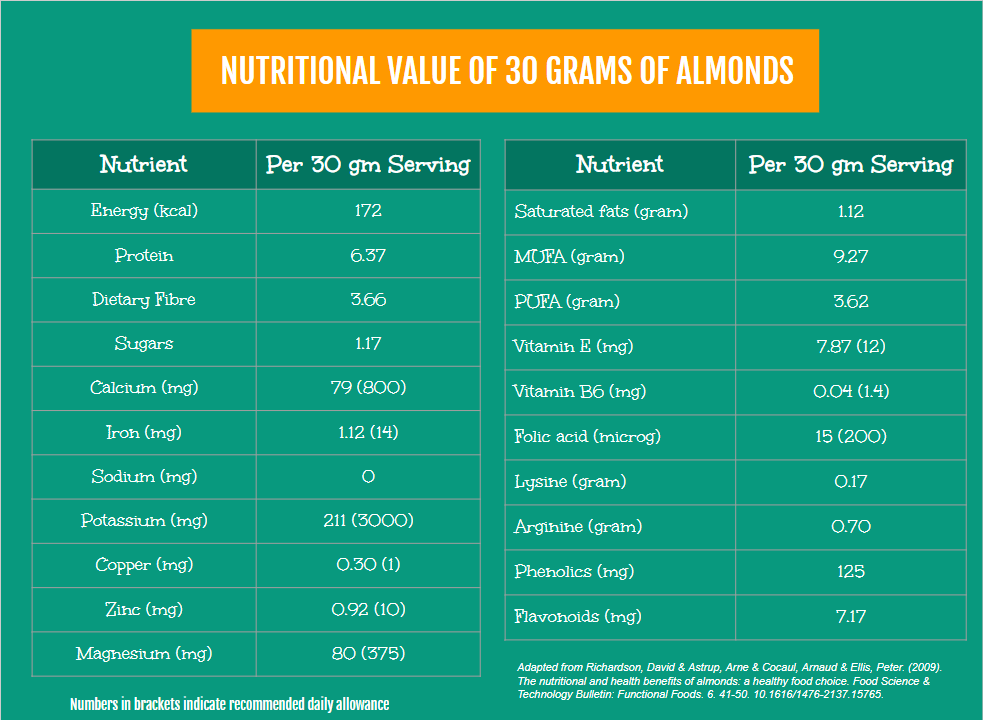
Almonds contain good fats
Almonds contain 50% fat in it.
While this may surprise you, given almonds are a ‘health food’, you will be pleased to know that it mostly has good fats in it. Almonds have predominantly mono-unsaturated fatty acids (MUFA), with very low saturated (bad) fats (3.7 gram per 100 grams). In fact, it has the lowest concentration of saturated fats among all the nuts.
Around 62% of the fats present in almonds are mono-unsaturated fatty acids, while 24% are poly-unsaturated fatty acids (PUFA – also a good fat).
These good fats have been shown to lower the risk of cardiac disease and protect the heart. They also lower total cholesterol levels.
Almonds are high in protein
A 30 gram serving of almonds contains around 6.5 grams of protein in it, making it an excellent protein source. In particular, almonds are rich in arginine – an amino acid that is important in a number of biological processes, essential for collagen synthesis and wound healing, and also to boost immunity.
Almonds contain high natural fiber
Almonds contain a good amount of fiber in them. A 30-gram portion has around 3.7 grams of dietary fiber in it.
Dietary fiber plays an important role in keeping your heart healthy and your bowels functioning normally. It has the property of regulating blood sugars as well.
The high fiber in almonds makes it a good snack as well. It keeps you fuller for longer and will keep you from snacking on junk foods now and again.
If you are ever hungry in between meals, munch on a handful of nuts.
Almonds are rich in phytosterols
Almonds do not contain any cholesterol. However, they do contain a compound closely related to cholesterol called phytosterols.
Phytosterols have the property of lowering the absorption of cholesterol from the gut. Over a period of time, it can aid in the reduction of your blood cholesterol levels.
Almonds are loaded with vitamins and minerals
One vitamin that almonds contain a good quantity of is vitamin E. Vitamin E has powerful antioxidant properties that can fight diseases such as cancer.
Other vitamins include b-complex and folic acid. It does not contain vitamin A.
Numerous minerals such as calcium, iron, phosphorus, zinc, copper, potassium and magnesium are present in naturally high quantities in almonds. They are low in sodium but high in potassium.
It is all these nutritional elements that make almonds one of the healthiest foods on the planet.
Health Benefits Of Almonds
When we look at how any food can impact one’s health, we look at the vital organs.
How do almonds protect the heart?
Do almonds reduce cholesterol levels?
Can almonds protect my memory?
Almonds Improve Heart Health
The health of our heart is dependent on numerous factors – exercise, diet, cholesterol levels, blood pressure, blood sugar and any vices we may have (smoking, alcohol intake, etc)
So when we evaluate the true benefits of any foods on heart health, we look at whether any of these parameters can be altered for the better.
Lowers Cholesterol
Let’s take a look at cholesterol, for example. The INTERHEART study, a robust clinical study looking at heart disease, clearly showed that high cholesterol levels can have a negative impact on heart health. In particular, high levels of LDL cholesterol, or bad cholesterol was associated with worse heart disease.
The high concentration of MUFA and PUFA in almonds make it a great food if you are looking to lower your cholesterol.
Studies have found that consuming 45 grams of almonds a day reduced the bad cholesterol levels significantly. Total cholesterol levels dropped by around 8 points (8mg/dL), while LDL reduced by around 5 points (5mg/dL).
Similarly, another study conducted in Pakistan found that almond consumption increased good cholesterol i.e. HDL levels in patients with coronary artery disease. Data has shown that every 10 point increase in HDL cholesterol halves your risk of heart disease.
Almonds are high in alpha-tocopherol, a compound closely related to vitamin E. It is believed to bear the cholesterol-lowering properties of almonds.
Controls Body Weight
Obesity is strongly linked to heart disease and a multitude of health issues. Excessive intake of snacks and junk food is a primary cause, along with the lack of exercise.
Almonds contain a significant amount of fat. So naturally, having a snack that is high in fat could increase body weight.

Fortunately, there are clinical studies that have shown that eating almonds as a snack over long periods of time does not have much bearing on body weight. In other words, it is unlikely to increase your weight.
This is because the absorption of energy from almonds is inefficient in the human body. Furthermore, they have a high satiety value, so it is unlikely you would snack too much on them.
When almonds are consumed as a part of a low-calorie diet, there seems to be a greater degree of weight loss.
It appears from available data that almonds are weight neutral. The weight loss that is seen would only be evident if a low-calorie diet were followed. However, snacking on almonds will not increase your weight.
This is probably because almonds have a high fiber content, which helps control body weight. Also, some of the fats in almonds are not absorbed well in the digestive tract and are expelled out in feces.
Overall, this would translate into almonds being healthy for your heart.
Almonds And Diabetes
I have diabetes – can I eat almonds?
Yes, you can!!
Almond consumption at the time of a meal has been shown to lower HbA1c levels and postprandial glucose levels. However, the effects on fasting glucose values are limited. Data is conflicting though, with other studies showing a beneficial effect on fasting glucose as well.

At the core of diabetes is a phenomenon called insulin resistance. Here, the cells in the body do not respond to the insulin that is secreted by the pancreas to help transport glucose from the blood into the cells and tissues.
Insulin resistance is the first phenomenon that eventually leads to not just diabetes, but also heart disease.
One way of assessing the presence of insulin resistance is measuring a parameter called homeostasis model assessment of insulin resistance index, or HOMA-IR index. A higher index indicates a higher chance of developing diabetes. Generally, South Asian populations have a higher HOMA-IR index compared to Caucasians.
Almonds have been found to lower the HOMA-IR index, which means they lower your chance of developing diabetes in the future.
A link has been found between low magnesium levels and diabetes in adults. Replacing magnesium appears to help bring blood sugar levels under control effectively. Almonds are a good source of magnesium, so they may be able to restore some normalcy to blood glucose levels in diabetes.
Almonds And Blood Pressure
An Indian study looking at almond intake over 24 weeks did not find any change in blood pressure values in the test subjects. . On the other hand, another study looking at intake on 84 grams of almonds every day over a 24 week period, combined with a low-calorie diet found an 11% reduction in the systolic blood pressure.
However, other studies have found that it might lower systolic blood pressure, but not diastolic blood pressure values.
There are some mechanisms through which almonds may lower your blood pressure. For example, the MUFA and PUFA I mentioned earlier have the property of lowering levels of a compound called thromboxane A2. Thromboxane A2 can constrict the blood vessels and hence increases BP. By lowering the levels, blood pressure could come down.
Similarly, the minerals in almonds could potentially lower blood pressure. Magnesium can stimulate the production of nitric oxide and prostacyclins. These are compounds that enlarge the blood vessels, lowering the pressure within them. This lowers blood pressure.
The potassium in almonds alters a hormone pathway in the kidney called the renin-angiotensin system, lowering blood pressure. Calcium can block the actions of a hormone called parathormone – a hormone secreted by the parathyroid gland, a small gland near your thyroid gland in the neck.
These are just possible mechanisms. There does not appear to be a strong link between eating almonds and lowering your blood pressure.
Almonds Lower Cancer Risk
Lab-based studies looking at anticancer effects of almonds have shown some effect in preventing oral cancer cells from growing. This is believed to be due to a compound called amygdalin in almonds (it is also found in apples, peaches, and blackberries).

Amygdalin is also effective in preventing the growth of cancer cells in prostate cancer, liver cancer, bladder cancer, and colon cancer, among a few others.
Rat studies have demonstrated that almonds may reduce the chances of cell growth in colon cancer. In another study looking at the intake of almonds, peanuts, and pine nuts, there was a significant lowering of the risk of developing colon cancer in both men and women. Some studies have even claimed the reduction to be to the tune of 24%.
There does not appear to be any benefit of eating almonds to prevent breast cancer. In fact, there might be some harm (I have discussed this later)
But how can almonds lower the risk of cancer?
Almonds are rich in multiple healthy elements – fiber, flavonoids, polyphenols, folic acid, and resveretrol, which are all powerful antioxidants. These compounds can reduce damage to DNA inside the cells, control how cells divide, and lower inflammation (all of these, when out of control, lead to cancer).
Almonds May Improve Your Memory
Memory loss is something many of us dread as we get older. Almonds are a natural solution to improving memory. Regular intake may also prevent Alzheimer’s disease.
When I looked up the clinical studies, I found that most of them were conducted in rodents, with limited studies done in humans.
Vitamin E has been shown to reduce the chances of developing Alzheimer’s disease. Since almonds are a good source of vitamin E, it stands to reason that it would help keep your memory sharp.
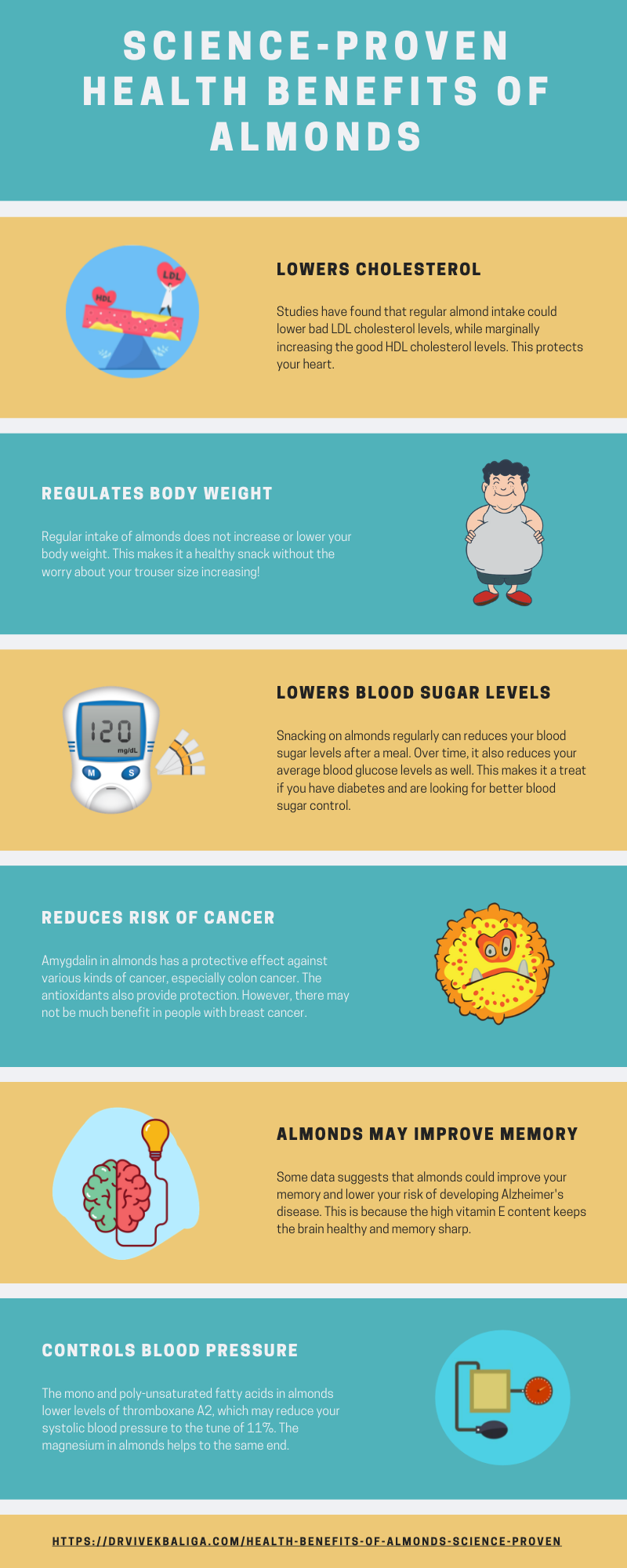
Can Eating Too Much Almonds Be Harmful?
You would think that given the health benefits of eating almonds daily, it is unlikely that there will be any side effects.
Unfortunately, too much of a good thing can be bad.
Almonds are rich in copper. Eating too many almonds every day can be harmful in women with breast cancer, as the copper can be harmful.
Those allergic to nuts should avoid almonds completely. If accidentally consumed, it could lead to skin eruptions, itching, swollen lips and tongue, difficulty swallowing, and breathing difficulty. I have even encountered a patient who is deathly allergic to nuts.
For this reason, when buying foods off the shelves in the supermarket, check the label to see if the product contains nuts.
Make sure the almonds you buy are unsalted. Salted almonds can be bad if you have high blood pressure.
Given the fiber content in almonds, excessive consumption can lead to bloating and digestive issues. It could also lead to an unhealthy increase in your vitamin E levels, which can have harmful effects.
To Soak Or Not To Soak
There is no clear data on this. However, the age-old tradition of soaking almonds overnight and eating them the next morning without the skins on appears to be the best way.
Almond skins contain a compound called tannins. These prevent the absorption of the nutrients during digestion. When soaked, the concentration of these tannins comes down. One such compound is d-myo-inositol hexaphosphate, which is significantly reduced, though to the tune of just under 5%.
Soaked almonds have a higher content of vitamin E, which may improve memory. Do note that soaking almonds does not make it easier to digest.
These facts notwithstanding, there is some evidence that the polyphenols in the skin of almonds have antioxidant properties. These polyphenols may have antibacterial properties as well, with the ability to fight numerous bacterial infections.
Personally, I feel you could either have them soaked or roasted. Either way, you will reap the health benefits.
How Much Almonds To Eat Everyday?
Studies have looked at anywhere between 30 to 45 grams of intake daily for benefits. Stick with a handful twice daily – that should be enough. It’s a healthy snack!
Closing Remarks
As a health food, almonds are among the champions. The nutritional content is remarkable. I strongly recommend you munch on some every day.
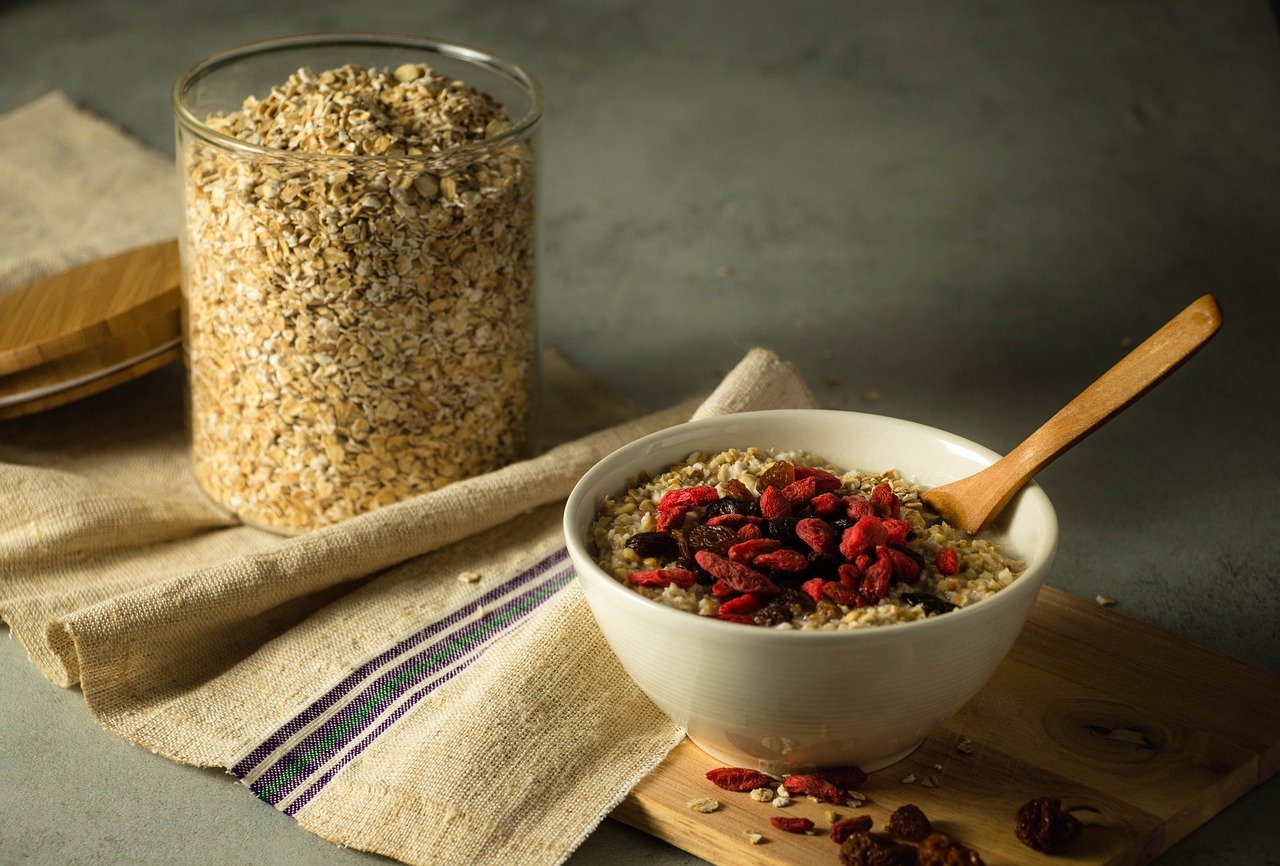
Health Benefits Of Oats – Scientific Truth Revealed Here!
I conducted a Google search on the ‘health benefits of oats’ and had a whopping 66 million results. So I decided to look through all the pages and have written this article based on what I found.
It has taken over a year.
Just kidding, well about the ‘reading 66 million articles’ thing anyway.
Oats have always been regarded as a super food, and many dietitians, nutritionists, bodybuilders and influencers swear by how good it is for health.
As you would expect as my reader, I have conducted an extensive scientific review of oats, and have revealed the truth about the health benefits of oats for you in this article.
I must admit right now – it’s quite something.
What Are Oats?
If you have been an oat connoisseur, then you will know that oats belong to the cereal family. In the world of biology, it is called Avena sativa.

The oat grain is covered in a husk that makes up 25 – 30% of the oat seed. Within the oat seed is endosperm, bran and an embryo.
Oats are generally had as a morning breakfast with milk and fruits. In India, oats upma and oats masala are quite popular. Oat bread is also available for consumption.
Types Of Oats
Oats are processed in different ways. Pearling, flaking, heat processing, kiln drying, steaming, germination, hydrothermal processing, rolling, steel cutting and extrusion cooking are the common types.
What we get in the market in India is either steel cut oats, instant oats or rolled oats.
Here are some of the common types you may come across –
1. Oat Groats
This is oats with the husk intact. However, anything inedible in the husk is removed. Oat groats are high in bran and the endosperm, and have a low glycemic index. This means they do not increase blood sugars much if consumed by someone with diabetes.
Oat groats contain high quantities of beta-glucan – around 2.3 – 8.5 grams/100 grams.
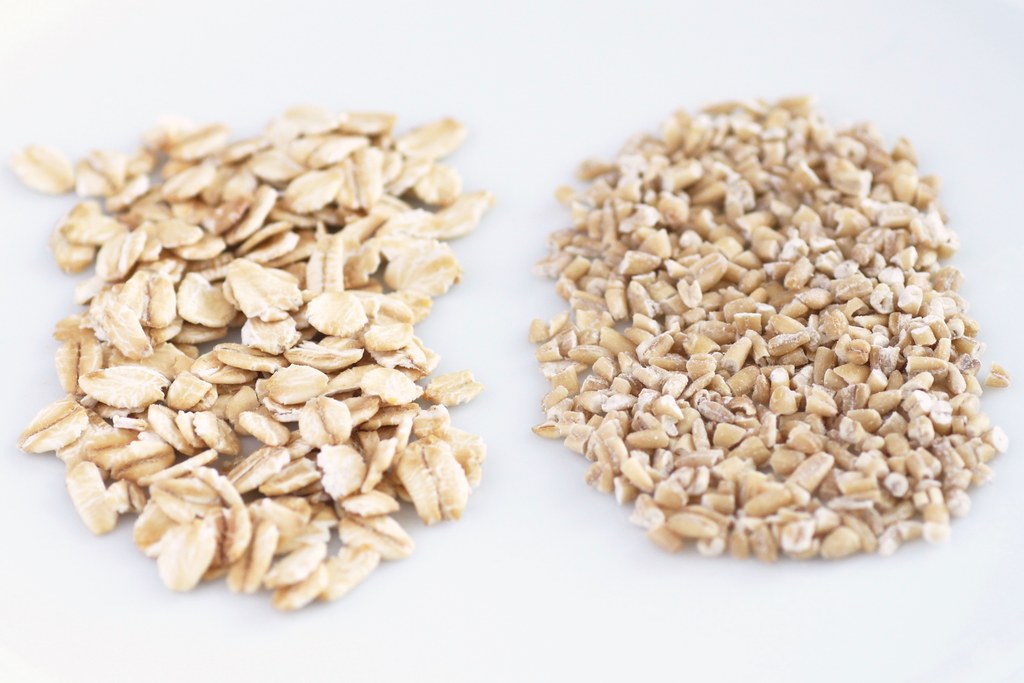
- Steel Cut Oats
This is also called Irish oats. Here, oat groats are cut into smaller pieces by a steel blade.
- Scottish Oats
Here, oat groats are ground using a stone into a fine powder (or small pieces).
- Rolled Oats
Oat groats are steamed first, then they are rolled and flattened. They are then dried completely prior to consumption.
Rolled oats are also called old fashioned oats.
- Instant Oats
Oat groats are steamed for a lot longer here. They are then rolled into small, thin pieces that can cook in minutes. Most of the instant cook oats fall in this category.
Generally, for health reasons, it is better to eat steel cut oats or oat groats, if you can find them. Instant oats have a higher glycemic index.
Nutritional Composition Of Oats
Oats are a well balanced cereal.
What I mean by this is that they have a good proportion of starches, unsaturated fats, vitamins, minerals and protein.
Let’s take a closer look at what oats contain.
Starch
Oats contain about 60% starch i.e. carbohydrates.
In general, foods contain 3 types of starch –
- Rapidly digestible starch
This starch, when broken down through digestion, increases blood glucose levels rapidly.
- Slowly digestible starch
This digests slowly, raising the blood glucose values in a gradual manner. In essence, it helps to keep blood glucose levels balanced. Foods that are high in slowly digestible carbohydrates are generally considered healthy.
- Resistant starch
This is a form of fiber. It bypasses the digestion process, and is fermented in the bowel by the bacteria in the colon. Resistant starch is probably the most important part of oats starches. It can help control appetite (prevents you from overeating), lowers blood sugar levels and maintains a healthy digestive tract.
Of the total starch in oats, 7% is rapidly digestible, 22% is slowly digestible and 25% is resistant starch. This is a healthy combination, making oats a ‘good carb’.
Protein
Oats contain about 11 – 15% protein. Oats are rich in amino acids (building block of protein) called lysine and threonine. These are available in lesser quantities in other cereals.
The process of germination of oats can increase its amino acid content from 19% to 22%. Germinated oats have a higher content of essential amino acids such as lysine and tryptophan.
Dietary Fiber
Dietary fiber is needed for 2 main purposes – for adequate digestion (to prevent constipation) and to protect the heart.
Basically, fiber is that component of food we eat that escapes digestion in the stomach. There are two types of fiber – soluble and insoluble. Soluble fiber is viscous and can protect the heart and maintain blood sugars. Insoluble fiber helps build stool bulk and prevents constipation.
The primary type of soluble fiber in oat groats is beta-glucan. Every 100 gram of oats contains around 2.3 – 8.5 grams of beta-glucan.
Beta-glucan is blessed with numerous health benefits, which I have discussed in various parts of this article. Oat bran has a higher proportion of beta-glucan as compared to the endosperm.
Fats
Oats are a good source of fats. It contains 5% to 9% of lipids in it. While this may shock you a little, you will be relieved to know that the type of fat that oats contain is unsaturated, healthy fats.
Vitamin E, Phytochemicals And Phenolic Compounds
Vitamin E is a powerful antioxidant that fights damaging free radicals.
Similarly, phytochemicals such as flavonoids, tocopherols etc also possess similar properties. Phenolic compounds in oats such as ferulic, caffeic, vanillic and hydroxybenzoic acid derivatives are also powerful antioxidants.
Short Chain Fatty Acids (SCFA)
SCFAs are end products of carbohydrate digestion. The main SCFAs that are generated in the bowel after digestion include acetate, butyrate and propionate.
While this might sound like Greek and Latin to you, what you need to know is the SCFAs are good for your gut health.
They improve the function of the cells that line the gut, enhancing their ability to fight infections. They also act on the liver, lowering production of harmful cholesterol.
There is some understanding that SCFAs may reduce hunger and increase satiety as well. In other words, they prevent you from snacking on junk food.
Avenanthramides
Also called AVA’s, avenanthramides are also powerful antioxidants that seem to be unique to oats. They are around 10 to 30 times more potent than phenolics I have mentioned earlier.
Health Benefits Of Oats
The main concern when it comes to health foods is whether intake of that particular food provides protection against heart disease. In India, many worry about health foods and diabetes control.
I will cover these first, and then make an honorary mention about the others.
Heart Health Benefits Of Oats
In general, there are not many studies that have looked at oats alone and its impact on heart health. Most studies look at whole grains in general.
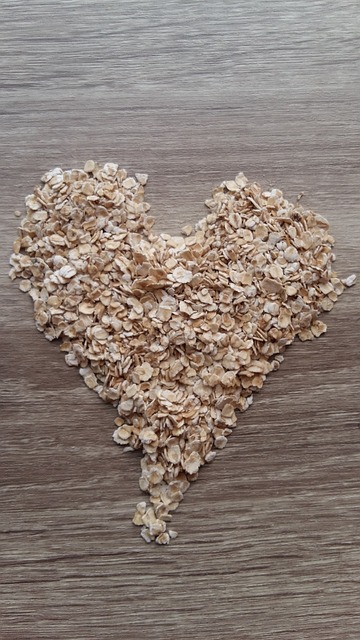
That being said, there are studies that have looked at how oat consumption can alter risk factors that can lead to heart disease.
For example, you would know that high cholesterol levels are linked to heart attacks and strokes. Lowering cholesterol levels, particularly LDL (bad cholesterol) levels can lower the chances of having a heart attack.
Long term consumption of oats can lower fasting cholesterol and LDL cholesterol levels. The reduction ranges from 3 to 10%. This leads to a reduction in heart attack risk by 6 to 18%. However, around 3 gram of beta glucan consumption is needed daily.
The primary mechanism through which cholesterol levels are affected by oats is the beta-glucan fiber affecting how cholesterol is manufactured in the body. Around 3 gram of beta glucan consumption is needed daily to lower cholesterol by 5% to 10%.
Another mechanism is through short chain fatty acids production that I discussed earlier.
Just like high cholesterol, high blood pressure is also a major risk factor for a heart attack or stroke. Keeping the blood pressure around 120-130/80 mmHg can lower your risk of cardiac disease by around 30%.
There is some benefit of oats in lowering blood pressure, though studies looking at this also had their subjects losing weight, which could have contributed to the blood pressure reduction. The best way to lower your blood pressure is to lower your salt intake.
All these benefits look good. But the studies are short (<12 weeks long), and there is no clear evidence that long term consumption of oats offers any additional benefits.
Oats Improve Glucose Levels In Diabetes
There is some evidence that increasing consumption of oats could help people suffering from type 2 diabetes. In particular, it reduced levels of fasting blood glucose and glycosylated hemoglobin (HbA1c) in those with diabetes.
Similar studies have also found that having oats for breakfast in the morning, when combined with a low fat high fiber diet, can lower postprandial glucose spikes.
It appears that this glucose lowering effect is due to beta-glucans in oats. Beta-glucan is a highly viscous compound that slows down stomach emptying after a meal. It also slows down absorption of glucose once carbohydrates have been broken down in the bowel.
Oats Can Help You Lose Weight
Oats are often consumed as a part of a weight loss diet.
In a short study conducted over 12 weeks, patients who consumed a predominantly oat based diet noticed a reduction in their body weight and lowering of their waist:hip ratio.
Oats can lower your hunger and improve satiety levels after consumption. This will prevent you from snacking in between meals. Beta-glucan is the reason for the high satiety levels.

Are Oats Safe If Intolerant To Gluten?
Gluten intolerance is a common problem in India and the rest of the world. It is a condition where individuals who eat wheat based foods, rava (semolina) and millets develop stomach bloating and loose stools.
One condition where gluten intolerance is the primary issue is coeliac disease. The small bowel lining, which is normally curvy and bendy becomes smooth and flat. A gluten free diet is the only treatment for this condition.
So do oats contain gluten?
The answer is no, they do not contain gluten. They contain Avenin, which is similar to gluten without the side effects.
Studies have found them to be perfectly safe in those who have gluten sensitivity. Authority bodies on coeliac disease also state the same.
However, it is necessary that the type of oats should be pure and not contaminated with wheat based products. The main reason why someone with gluten sensitivity develops problems with oats is cross-contamination with wheat.
If you are sensitive to gluten and are following a gluten free diet, you are risking not having sufficient vitamins and essential nutrients in your diet. Just add oats to the diet and you can make up for any losses.
Closing Remarks
Oats are no doubt a super-food, and there are multiple health benefits of oats. The beta-glucan is the super-hero in all of this.
Make sure you include a good quantity of oats in your diet. Choose steel cut oats or oat groats if they are available to you.

Health Benefits Of Curcumin In Turmeric
Time and again, I have heard people tell me that they drink a glass of warm water or milk with turmeric mixed in it every morning. They do this to get the health benefits of curcumin in turmeric.
Curcumin is the active component of turmeric.
I thought I would talk about the health benefits of turmeric, particularly its primary active component. As always, I have reference numerous scientific studies in this article, as evident from the links.
What Is Turmeric?
Turmeric, or Curcuma longa, is a rhizomatous perennial plant that is closely related to ginger. It has been used for thousands of years for its medicinal properties, though the mechanism through which it works has only been discovered recently. It is called the ‘golden spice’ due to its brilliant yellow-gold color.

In fact, around 250 BC, Susruta used turmeric in an ointment that was used to treat people who had consumed poisonous foods.
Turmeric grows best between temperatures of 20 – 30 degrees C, and requires a lot of rainfall to grow well. It is produced almost exclusively in India, and we are it’s primary consumers as well.
Curcumin is a polyphenol (1,7-bis(4-hydroxy-3-methoxyphenyl)-1,6-heptadiene-3,5-dione) that has numerous anti-inflammatory, anti-cancer, antimicrobial and antioxidant properties.
There are numerous other benefits of curcumin in turmeric that I will be discussing here. One teaspoon of turmeric contains around 200 mg of curcumin.
To get the most out of curcumin and to reap the maximum health benefit, one should consume around 1000 mg to 1200 mg of curcumin a day (that’s around 5 teaspoons of turmeric a day). Even doses up to 8 grams a day seem to be safe, though you may not need that much to get all the benefits.
How Curcumin Protects Your Health
The primary mechanism of action of curcumin is through antioxidant and anti-inflammatory properties.

Our body is exposed to numerous stressors every day. Pollution, work related stress, unhealthy diets, lack of exercise and lack of sleep can all lead to the formation of free radicals in the body.
Free radicals are harmful to all the vital organs, and affect the way they function. The way they harm is called oxidative stress.
Curcumin increases the level of activity of a compound called SuperOxide Dismutase, or SOD. This works to get rid of oxidative stress by neutralizing the free radicals in the blood.
Not just that; curcumin can also increase the levels of reactive oxygen and nitrogen species. These compounds have a property of ‘gobbling up’ all these free radicals.
In addition to the antioxidant properties, curcumin is a powerful anti-inflammatory agent. Inflammation is a key part of conditions such as Parkinson’s disease, Alzheimer’s disease, heart attacks and depression, including diabetes, high blood pressure, asthma, lung disease and low immunity.
The anti-inflammatory properties are exerted through a reduction in the levels of compounds that are ‘pro-inflammatory’ – meaning they worsen inflammation. The primary pro-inflammatory compound that is countered is Tumor Necrosis Factor, or TNF.
There are of course numerous other compounds whose harmful effects are blocked, but I will not go into too much detail as it will likely confuse matters (or just bore you!)
Health Benefits of Curcumin In Turmeric
Let’s look at its benefits in healthy people first. After that, I will discuss specific conditions where you can reap the health benefits of curcumin in turmeric.
Healthy People
There are not many clinical studies conducted that clearly define the benefits of curcumin in people who are healthy and free from disease. Studies have primarily looked at high levels of curcumin ingestion – something that you would not get should you have turmeric as an addition to your diet.
I personally do not like to prescribe a curcumin supplement to people who are perfectly healthy. I just don’t see the real need. But there is nothing wrong in taking it if you wish to.
In one study that looked at regular administration of 80 mg of curcumin a day for 4 weeks, study subjects had a significant lowering of their triglyceride levels, but not the remainder of the cholesterol values.
Curcumin also increased the levels of a compound called nitric oxide in the body. Nitric oxide has a property of improving blood flow in the body and to the heart muscle.
It also reduced the quantity of a protein called beta-amyloid. This protein is a marker for brain ageing, with higher levels seen in an aged brain (have discussed this later).
But that’s not all folks.
Long term treatment with curcumin can over a period of time improve memory and mood, enhance alertness and make you an ‘all round chilled out’ person!
As you can see, the benefits are many in healthy people. So try to make curcumin a part of your daily diet – or choose a supplement if you wish to.
Arthritis
Osteoarthritis (OA) is a common problem affecting millions globally. The aches and pains in the joints can sometimes be debilitating, negatively impacting quality of life. Unfortunately, there is no cure.
Painkillers in the form of paracetamol or non-steroidal anti-inflammatory drugs are prescribed like smarties for patients to help them deal with the pain.
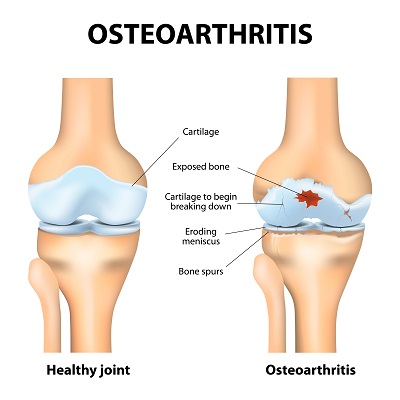
Interestingly, curcumin can be the solution you have been looking for.
Various studies have found that taking around 1 gram or more of curcumin for a prolonged period of time can lower pain and improve physical function in OA. However, the stiffness in the joints is often not improved. The effects are believed to be exerted locally within the joint.
A study comparing curcumin to ibuprofen, a popular painkiller, found that they both worked to the same effect, offering the same symptom relief. The advantage of curcumin is that it is natural and has no side effects, compared to ibuprofen and other such medicines that can cause acidity and other related symptoms.
Do note that the dose of curcumin needed everyday to improve joint pains is 2 grams (that’s around 10 teaspoons of turmeric powder daily – better to take a supplement).
Obesity, Diabetes and Metabolic Syndrome
Curcumin exerts anti-obesity and anti-diabetic effects in a number of different ways. Primarily, the anti-inflammatory effect it exerts on the body helps lower the risk of development of metabolic syndrome and insulin resistance.
Insulin resistance is a condition where the body stops responding to the natural insulin being produced by the pancreas to control glucose entry into the cells. This glucose entry is essential to provide vital organs with the nourishment they need.
Insulin resistance is the core problem in the development of diabetes and obesity. It is closely linked to heart disease and strokes as well.
By improving insulin resistance, curcumin can lower your risk of developing metabolic syndrome and its consequences. It is one of the remarkable health benefits of curcumin.
In patients with diabetes, regular curcumin use can lower HbA1c levels. It can also lower the risk of developing complications from diabetes. In particular, it helps reduce nerve pain in the hands and feet.
Cancer
Curcumin has an anti-mutagenic effect. This means that it prevents the growth of cells that can lead to cancer. It does this through its antioxidant effects.
It has been shown in studies to deactivate the cancer causing compounds in smoke from cigarettes. Similar effects have been shown in prostate cancer. In people with skin cancer (melanoma), curcumin may prevent spread of the cancer cells (metastasis).
Heart Disease
In addition to the cholesterol lowering effects I mentioned earlier, one of the benefits of curcumin is that it specifically targets atherosclerosis, the root cause of heart disease.
Once again, this has to do with its antioxidant effects, along with its effects of lowering the levels of toxic inflammatory compounds in the blood called cytokines. By doing so, it reduces the damage blood vessels face from these toxic compounds, keeping them healthy.
But the effects of curcumin extend beyond that.
In a wonderful review that I had read about the health benefits of curcumin in heart disease, evidence suggests that curcumin can decrease the extent to which the heart is affected should a heart attack occur.
To explain further, a heart attack occurs when an artery of the heart is blocked by a blood clot. Heart muscle damage is almost instant. Sometimes the extent of damage can be so severe that the heart becomes extremely weak. Mouse studies have found that when curcumin is administered after a heart attack, the extent to which the heart is involved is lesser.
This means that the heart will not be that badly affected, and recovery would be quicker and better.
Doxorubicin is a chemotherapy drug that is used in the treatment of breast cancer and certain blood cancers. A side effect of this drug is weakening of the heart muscle. Curcumin has been found to lower the chances of this happening.
Dementia
Personally, I dread that there is a chance that at some point in life I will lose my memory. The birth of my son, the time with my family and friends, and the faces and personalities of the people I have met in my lifetime might become just one big blur.

Just the thought of it is frightening, so I cannot imagine how it might feel for someone who is experiencing it already.
There has been extensive research done in dementia, or memory loss, over the years. Inflammation and oxidative stress have been cited as possible causes. Cardiac risk factors such as high blood pressure, high cholesterol and diabetes are also risk factors for dementia.
I was hoping that there would be some data suggesting curcumin to be a solution to memory loss. Sadly, there isn’t much evidence out there that describes its direct impact. Some studies have suggested that there may be a reduction in a protein called amyloid-beta that has been implicated in Alzheimer’s disease.
Levels of inflammation within the nerve fibers of the brain (neuro-inflammation) may also be reduced.
Given the effect curcumin has on diabetes and other cardiac risk factors, it stands to reason that dementia and Alzheimer’s disease progression and onset would certainly be slowed down.
As it is, there might in fact be benefits in taking a curcumin supplement regularly not to improve memory, but to lower your chances of memory loss as you age.
Dental And Skin Health
Rubbing turmeric on the gums and gargling turmeric in water has been found to cleanse the mouth and reduce dental plaque. It can be a good mouthwash as it has antibacterial properties.
Applied on the skin, it can reduce blemishes, acne and dermatitis (remember Vicco Turmeric cream?!).
Other Health Benefits Of Curcumin
Curcumin seems to be able to fight the malarial parasite, and may have uses in people suffering from malaria. In fact, in a study conducted in mice, curcumin reduced the malarial parasite load by around 80% – 90% in mice affected by malaria.
Turmeric also protects the liver and the kidney through the same antioxidant and anti-inflammatory effects I have described earlier.
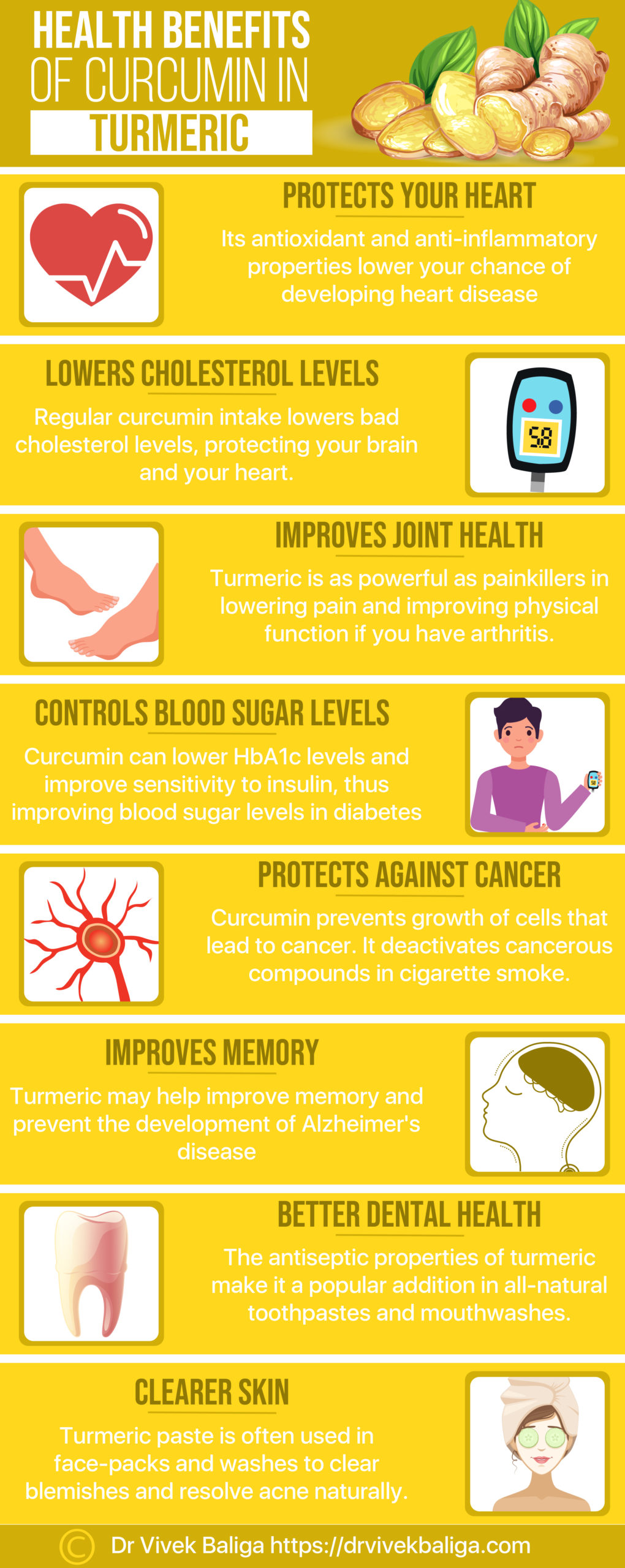
Share this Image On Your Site
Side Effects
As such, consumed in recommended quantities, turmeric (and hence curcumin) has no reported side effects and is perfectly safe, even in higher doses.
However, in men taking turmeric in high quantities, there can be a reduction in sperm motility. If you are trying to have a family, then men need to stop taking any turmeric supplements.
It is not recommended as a contraceptive on its own, even though it has that effect. It is better to use other proven methods instead.
Does Cooking Destroy Curcumin?
Most Indian dishes have turmeric added, either for taste or for color. But does the cooking process destroy the benefits of curcumin?
One study found that frying turmeric can weaken curcumin and its antioxidant effect. Instead, boiling or dry roasting may be better. However, the full benefit cannot be obtained following any cooking process.
How To Include Curcumin In Your Diet
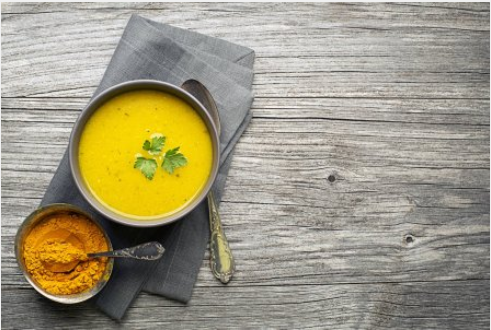
You could still carry out your early morning routine of turmeric in water. But that is not enough. Also note that you need to add pepper to the water as well, as piperine in pepper helps enhance absorption of curcumin by nearly 2000%!
Turmeric added to cooking can give you an additional boost. You could even try turmeric, ginger and carrot soup. Its quite delightful. Some people have tried turmeric infused tea.
Cost Of Curcumin Supplements
Consuming turmeric alone to get your daily dose of curcumin requires you to have between 6 to 10 teaspoons of turmeric every day. This is not really possible for all.
Curcumin extract capsules are available in the market, but are expensive. The best quality ones cost around Rs 24 a gel capsule. You will need at least 3 to 4 per day of these.
You may want to take it only if you can afford it.
Closing Remarks
There is no doubt that there are numerous health benefits of curcumin in turmeric. The best part is that there are no side effects reported.
Getting the right dose of curcumin in your diet every day can be hard though. You may want to talk to your doctor about getting a supplement instead.

Himalayan Pink Salt – Is It Really A Big Deal?
I have heard time and again people telling me they use Himalayan pink salt (Saindhava Lavana) as it is ‘healthier’. I personally have never used the salt, having mostly utilised table salt in our cooked food at home.
I thought I would take a look at Himalayan pink salt, what the benefits really are, and whether it is worth shifting to this salt when cooking food at our home.
I looked through Google Scholar, authority sites and Pubmed for any available evidence. I was tremendously disappointed at the lack of any scientific publications looking at it’s true benefits.
This notwithstanding, here is what I have learnt.
A Brief Review Of History Of Salt
Years ago, salt was a highly valued commodity. It was a part of development of numerous civilizations, including the Roman, Greeks and the Chinese. In fact, the Romans built roads so that salt could be transported faster into the city. Salt was even used as wages for Roman soldiers.
What Is Salt?
When we talk of salt, we are essentially talking about sodium chloride, or NaCl. Traditionally, salt that was available contained 40% sodium and 60% chloride in it. This was the purest form of salt.
We need salt to live. Sodium is needed to regulate vital organ function, especially brain function. Those low in sodium tend to be tired and even confused. I have encountered multiple cases of coma due to low blood sodium levels over the years.

The table salt we purchase from the shops contains sodium chloride in addition to anti-caking agents (such as iodine, sodium silicates, aluminium ferrocyanide and sodium ferrocyanide – dont’ worry, all legal!) that prevent the salt from holding onto water and forming clumps.
Iodine is added to prevent thyroid disease. Years ago, thyroid disease (goitre) was common in people who had low iodine intake. The Salt iodisation program evolved from a study conducted by Professor V Ramalingaswamy in the Kangra Valley of Himachal Pradesh back in the 1950s.
There are numerous types of salt available other than the regular table salt. Himalayan pink salt is one of them. Others include rock salt, Indian black salt (kala namak), Maldon salt, Kilauea Black salt, Bolivian Rose salt and many others.
Let’s talk about Himalayan Pink salt.
What Is Himalayan Pink Salt?
Himalayan pink salt is a variety of salt that is mined from the Khewra Salt Mine, located at the foothills of the Himalayas within Pakistan (well, in between Islamabad and Lahore). The mining process preserves most of the minerals and trace elements within the salt.

It is pink in color because of the small amount of iron oxide (rust) that it contains.
In addition to this, it contains a wide variety of minerals within it (apparently 84 different minerals and trace elements), making it ‘more nutritious’ compared to the regular table salt we use in cooking.
Pink salt has been heralded as a ‘health food’ with multiple benefits by not just companies manufacturing the product, but also by celebrities and influencers globally.
But is it really so?
Nutritional Content Of Himalayan Pink Salt
If you look at the nutritional content of Himalayan Pink salt, it contains slightly higher quantities of calcium, potassium, magnesium, iron and molybdenum compared to table salt. It only has a marginally lower level of sodium.
In fact, the total content of sodium in pink salt is 98%. Only 2% are the trace minerals I have mentioned above.
Given that it is mined in a special way and does not require any additives, it makes it a little healthier compared to table salt.
Any True Benefits Of Himalayan Pink Salt?
Let’s take a look at a few aspects
Sodium Content
The main concern with any salt is sodium content. It is well known that a high intake of sodium on a regular basis can lead to high blood pressure.
In those people taking medical treatment for high blood pressure, a high intake of sodium can worsen blood pressure and lead to poor control. This increases the risk of heart attacks and strokes.
There is no significant difference between the sodium content of table salt and pink salt. One gram of table salt has 381 mg of sodium, while 1 gram of pink salt has 368 mg of sodium.
That’s a small difference.
On the other hand, the potassium content of pink salt is 3 times higher than table salt.
So if you are looking to use Himalayan pink salt as a replacement for table salt, think again. The sodium content is only slightly lesser in the former, and you may need to add a little more pink salt to your food to get the same taste as table salt.
Also, if you have hypertension, I recommend avoiding pink salt. This is because it too contains harmful sodium, and the potassium levels are higher. Certain medicines prescribed for high blood pressure cause retention of potassium, so consuming pink salt can only add insult to injury. Follow a low salt diet instead.
Iodine Content
As I mentioned earlier, iodine is essential to maintain healthy thyroid function. Iodine is available in dairy, fish and eggs.
Pink salt has very little if no iodine in it, making it less healthy compared to iodised table salt.
Additional Minerals And Trace Elements
It is believed that there are 84 additional minerals and trace elements in pink salt compared to table salt.
But the quantities of these minerals is so small, it is unlikely to have any benefit on your health whatsoever. In fact, to truly obtain any benefit, you might need to consume a kilo of pink salt daily!
Cost
This may not be too relevant, but pink salt is considerably more expensive compared to iodised table salt.
Not something you want to pass around liberally at the dinner table.
Additives
Himalayan pink salt has no additives, and is purely natural. On the other hand, table salt has anti-caking agents to prevent it from forming clumps.
There is no evidence that these anti-caking agents are harmful in any way to humans. If you feel seriously about it, then you can make the switch to pink salt. Just make sure you get your iodine from elsewhere.
Himalayan Pink Salt Lamps

So I found that they are using pink salt in lamps, as they have a soothing effect on the body and mind. It supposedly helps treat seasonal affective disorder, increase energy levels and improve sleep.
It is believed to do so by releasing negative ions into the air, getting rid of ‘harmful positive ions’. There is some understanding that high density negative ions may help treat depression in seasonal affective disorder.
It’s a hit in spas. You might pay more for the room just having a lamp in there.
But there appears to be little real benefit. There are no scientific studies really proving the fact.
Closing Remarks
There is no doubt that Himalayan Pink Salt is different from table salt. But honestly speaking, it does not confer any greater benefit in comparison.
Whichever salt you decide to use, make sure you do not use too much, as it can affect your health.
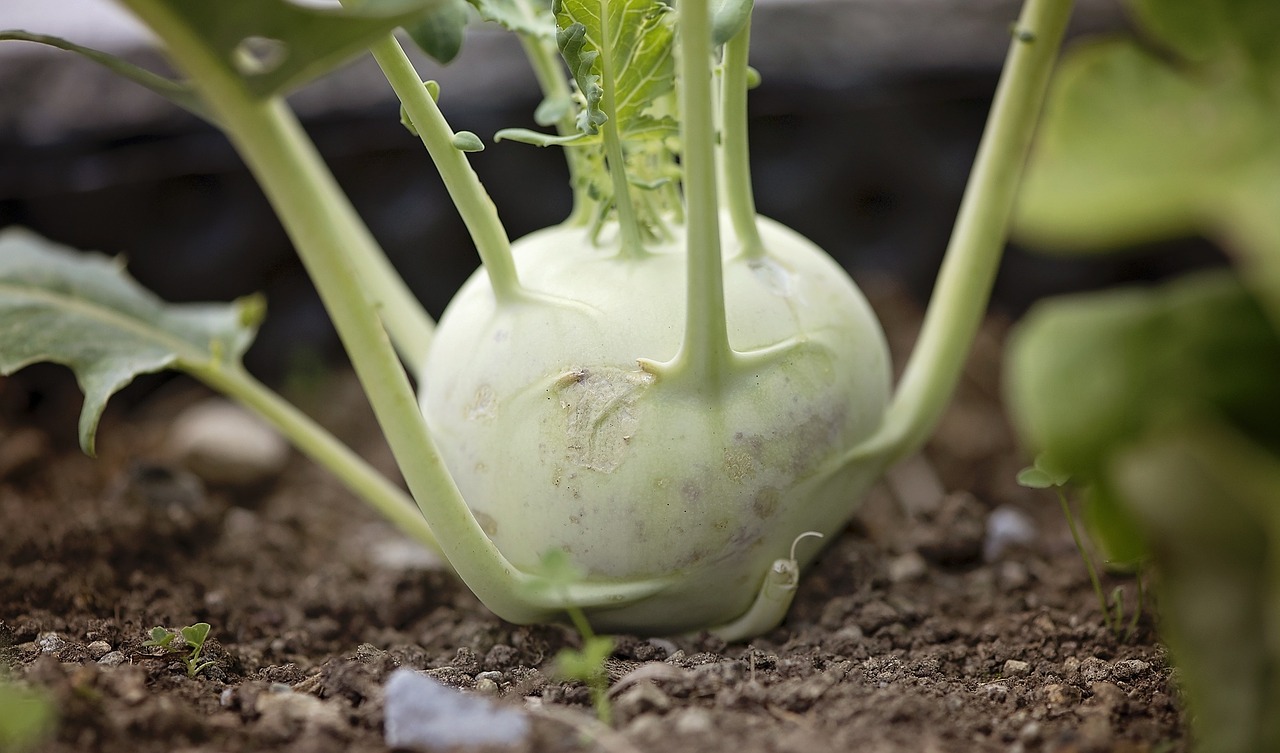
Kohlrabi And Your Health
Honestly speaking, I have never really understood Kohlrabi.
Also called Knol Khol locally, this vegetable has hidden benefits that quite baffled me. I never knew that this ‘German Turnip’ was not really a turnip, but closely related to cabbage!
Firstly, the kohlrabi is rich in vitamin C. Vitamin C is a powerful antioxidant that has the power to fight the common cold and boost up immunity. The other antioxidants are believed to have the ability to ward off diabetes and premature death.
The high fiber content of this veggie can protect your heart and also help you maintain a healthy bowel. A single cup of Kohlrabi can provide you with nearly 20% of your daily fiber need. Compounds called glucosinolates and isothiocyanates can open your blood vessels, allow for better flow of blood through the arteries, this improving overall heart health.
Kohrabi also contains B complex vitamins, particularly vitamin B6. This vitamin helps maintain the health of blood cells, preventing anemia. Vitamin B6 is also needed to keep your white blood cells in attention at all times, helping fight infections swiftly when bacteria or viruses attack.
At home, we generally have kohlrabi lightly sautéed with come chilli, mustard seeds and coconut. Personally, I love it and make sure I have it when it is in season. Come on, give it a try today!

Basics Of Coronavirus – A Presentation
For those of you who know me, I like to make short presentations now and again that summarize major health problems.
The coronavirus is taking the world by storm. It seems to be spreading fast, and many are panicking.
I have written about this virus elsewhere, but I thought I would share a presentation that I have made about this virus with you.

Medical Mysteries That Have Baffled The World
Once in a while, medical practitioners come across certain medical cases that have left them completely dumbfounded.
These are the rarest of the rare, with hardly an expert to say they have the experience in managing them. I found for you some cases that have left many a mind confused and doctor baffled.
1. The Child Who Cried Stones
Yes, you read that right.
Believe it or not, there was a girl in Yemen whose father once noticed her crying stones. Yemeni father Mohammad Saleh Al Jaharani was astonished when his eight-year-old daughter Saadia started crying tiny stones instead of tears.
So far, doctors have not been able to figure out what the cause for this is. Unsurprisingly, people in the village believe the girl is under some sort of spell. Apparently, she could cry out around 100 stones a day.
2. The Girl Who Did Not Age
Brooke Greenberg was a girl with a difference.
She was 20 years old, still had her baby teeth and her bones were still as thin as a 10-year-old. Physically, she was no taller than a 2 year old, and had a similar mental capacity as well.
The only things that grew normally included her hair and fingernails. Clinical studies of her brain found it to be highly underdeveloped. Sadly, she passed away at the tender age of 20 yrs.
A diagnosis was never made.
3. Blindness Miraculously Restored
Lisa Reid of New Zealand is probably one of the luckiest persons on planet Earth.
Having lost her vision at the age of 11 years, she was prepared to lead a life lead by darkness and just by smell and touch. When she was 24 years, she accidentally bumped her head.
Wonder of wonders, she regained her sight suddenly!
Her initial loss of vision was believed to be due to a tumor pressing on the optic nerve. After bumping her head when bending down to pet her dog, Lisa went to bed with just a headache. She woke up with perfect vision.
A bit like Spiderman waking up with his newfound powers.
4. The Girl Who Felt No Pain
Meet Gabby Gingras. A little girl who poked her eye out and maimed 3 of her fingers.
Why, you ask?
Well, she can’t feel any pain whatsoever. She would bang her head against the sharp edge of the table and behave as though nothing had happened. She suffers from hereditary sensory autonomic neuropathy – a condition where the nerves responsible for sensation do not work. At one point in her life, the poor girl had broken her jaw, and no one had noticed, not even her.
5. The Mysterious Case of Gloria Ramirez
I save the most baffling one for last.
On Feb 19th, 1994, Gloria Ramirez was admitted to Riverside Hospital in the USA. She had a history of cervical cancer and was brought to the emergency department with breathlessness and a fast heart rate.
When she arrived, doctors noted her skin to have an oily sheen, and a fruity garlic odor was emanating from her mouth. Blood samples that were taken smelt like ammonia.
A short while later, the nurse who drew the blood fainted. A little while after, the doctor treating her started vomiting, following which even she fainted. A therapist on the ward also fainted shortly after.
Within a matter of minutes, 23 people fell ill and 5 required hospitalization.
All the patients in the hospital were moved out to the parking lot. Shortly after, Mrs Ramirez went into cardiac arrest and died despite resuscitation attempts.
So far, no clear cause has been found out, though investigators believe that her body might have been covered with dimethyl sulphur, a compound used to relieve pain. The temperature drop when Mrs Ramirez was moved from her home to the hospital might have converted it into a volatile gas, leading to the symptoms.
Baffling, right?
